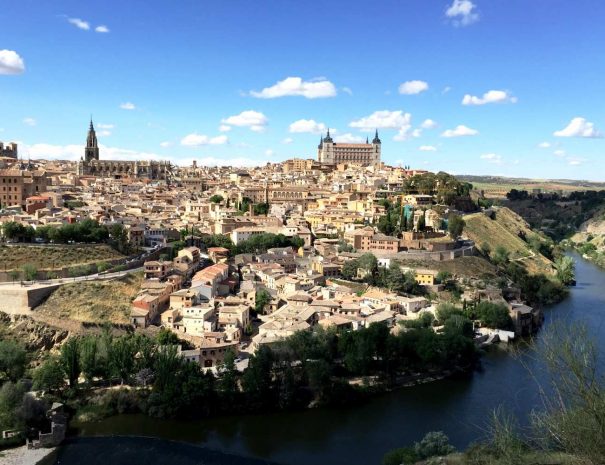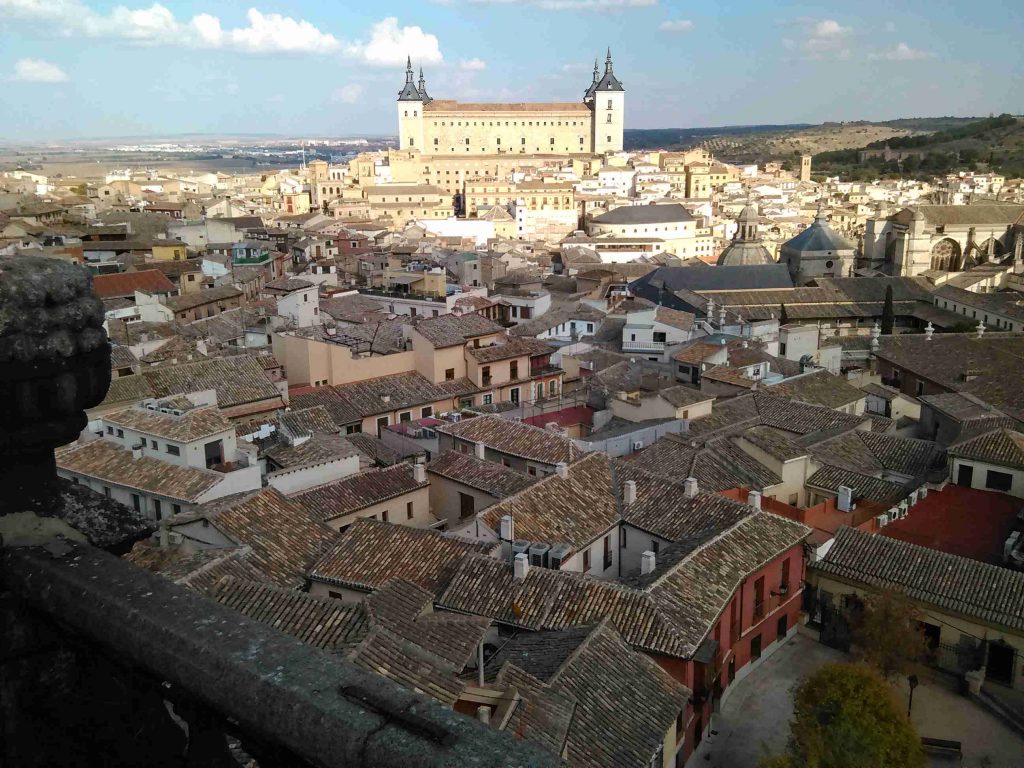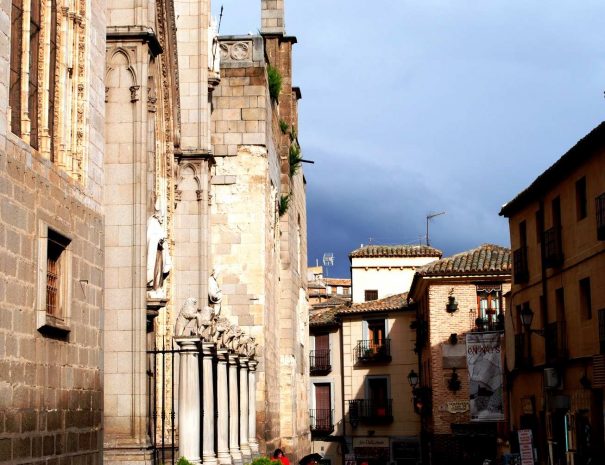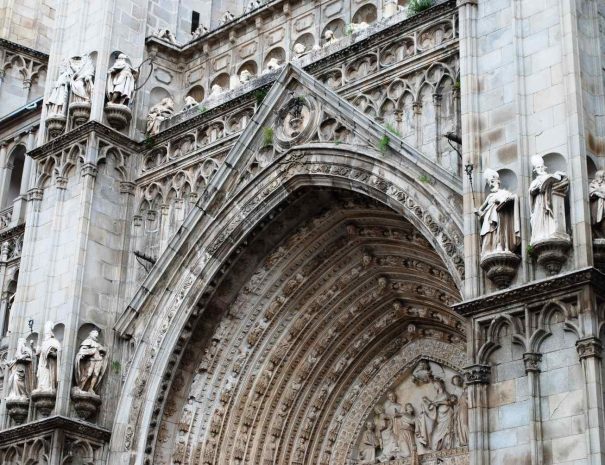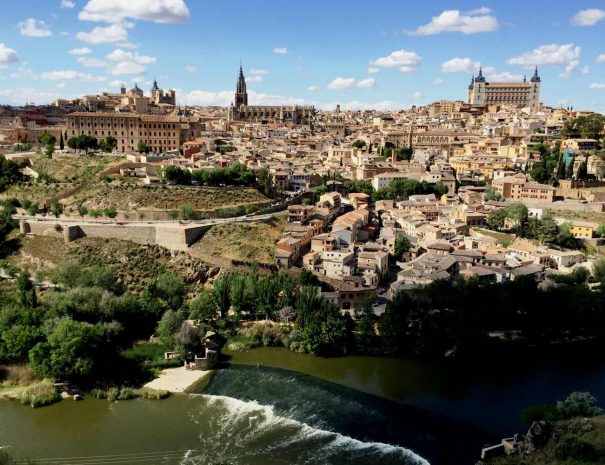Toledo Spain offers a unique experience for the senses and a journey through time. Remnants of ancient Romans can be seen through the historic streets and buildings, while the story of Muslims, Christians, and Jews is deeply entwined with the city’s culture. Despite the many tourist traps, traditional and hearty cuisine is still served in family-run taverns, providing a taste of the city’s long-standing heritage.
A tour to Toledo is one of the best options to enjoy a day private tour in Spain. Having said this, there are a myriad of options departing daily from Madrid, mainly group tours.
Where is Toledo Spain located?
Toledo lies in the northern part of Castilla-La Mancha, an autonomous region adjacent to Madrid to the south. The distance between Madrid and Toledo is approximately 72 kilometers (45 miles), allowing for a journey from the Spanish capital in under an hour.
Best way to enjoy a Tour to Toledo, Spain
The nearest airport to Toledo, Spain is Madrid. Madrid is located at 1-hour drive from Toledo. Toledo can be reached by motorway from Madrid, but also by high-speed train (30 minutes from Atocha train station to Toledo). Most visitors to Toledo get to the city using a day tour from Madrid since in this way they avoid having to change hotels often.
What is the best season to visit Toledo?
The weather in Toledo is continental and summers can be hotel (July and August) In our opinion the best months to enjoy Toledo are April, May, June (though it can be very busy if a tour is booked at Corpus Cristi), September and October.
How is the food from Toledo and traditional dishes?
Local gastronomy in Toledo is influenced by the cultural heritage of the city. Different civilisations co-existed in Toledo for centuries and this impacted local dishes. Toledo´s most famous food is marzipan, a local sweet made with almonds, sugar and egg yolks. Another famous dish, this time a tapa, is carcamusa. Carcamusa is a stew served in a small pot (a cazuela) This typical stew is made with slowed cooked pork, peas, tomatoes and white wine. It is served in a small clay pot or cazuela. The third most outstanding dishes in Toledo are game dishes. The region of Toledo is home to both big and small wild game and the most well-known dishes are venison and the red partridge.
Since Toledo receives so many tourists every day, there are many restaurants that offer mediocre food and menus. The situation has however improved a lot in recent years, and a growing number of restaurants located in the most touristic streets offer today reasonable menus.
What are the top highlights in Toledo?
The whole historic center of Toledo can be described as a monument or an open-air museum. This Unesco heritage site offers a lot for a day tour. The Cathedral (Catedral Primada) is for many experts the best example of Gothic architecture in Spain. Its construction started in 1226 and it took “only” 250 years to get it completed. The Monastery of San Juan de los Reyes is another top highlight in the city. It was commissioned by the Reyes Catolicos. El Puente de San Martin, not far from the Monastery is one of the most beautiful bridges in Spain. There are many more top attractions in Toledo, including two synagogues, the Greco Museum, the outstanding Iglesia de San Ildefonso, la Puerta de Bisagra or the beautiful Alcantara bridge. Toledo is so amazing that some top sights like Zocodover square are almost neglected by visitors that enjoy a day tour in the city. The amazing heritage of Toledo has contributed to its inclusion in the Unesco Heritage sites. The Unesco site is worth reading prior to a tour in the city to understand the most important things that make of Toledo such an amazing place to visit.
Toledo, is a perfect city to enjoy Spain´s Jewish history
The Sinagoga del Transito is a true jewel of Sephardic heritage in Spain. The synagogue was built at a time in which building sinagogues was not permitted. At that time Pedro I was King and his treasurer was Samuel Levi. The King permitted Samuel to build the Sinagogue. Both the decorations and the dimension of the Sinagogue are impressive. But this is not the only jewel Toledo offers for those seeking to understand jewish heritage. The Sinagona Santa Maria La Blanca and also the Puerta del Cambron (the gate to the judería or jewish quarter). The Jewish were expelled from Spain in 1492, the same year Columbus arrived to America. Though there are not clear statistics, some studies propose the number of 200,000 people expelled and many more converted.
If you are visiting Toledo on your own and if you have enough time, your walking tour should include a stop at the Iglesia de San Ildefonso. It offers fantastic views of the city but you will need to climb to its tower. However, most tours to the city include stops on the other side of the Tagus river. The views or vistas from different areas of this road outside Toledo are breath-taking. This is one of the things you would miss if you get to Toledo on train.
El Greco and Toledo
El Greco is an icon painter. His style is unmistakable and holds a top position in the history of European art. Born in Crete, el Greco studied in Venice and Rome and he then settled in Toledo, where he found the patronage of several rich people. He was, like many geniuses, an extravagant character. Toledo holds a museum dedicated to his art, and also a good number of pieces can be enjoyed at the Convento de Santo Domingo El Antiguo. But the top highlight for El Greco lovers is Santo Tomé, where the famous painting, the burial of Conde Orgaz is not to be missed.
Are tours to Toledo a good option for Seniors?
Toledo is not the easiest city to walk and you will have to be realistic because there are many things to see and enjoy and you will not be able to “do it all”. Most streets in the old city are cobbled and comfortable shoes are a must. There are some hilly streets but since it hardly rains, the streets are not slippery. Unless you have serious mobility issues you should be able to enjoy a guided tour in Toledo, or be able to stroll at your own pace. In summertime the most important touristic streets are covered with canopies to create artificial shadows.
Are tours to Toledo good for children?
Many children will find Toledo a dream come true: stone walls, ancient streets that look like a maze, and attractions like the torture museum, which can be of special interest to older children. Even at places like the cathedral´s museum kids can become mesmerized by its size and the amazing stained glass windows and gold relics.
There are many things to see and walking up and down in Toledo can get tiring for kinds and adults alike. You have to be realistic about your objectives for the day. If you decide to visit the city by train we would strongly recommend not walking from the station but rather taking a taxi to avoid unnecessary walking time.
Best souvenirs and gifts to buy in Toledo
For a truly authentic souvenir from your Toledo day trip, why not pick up a locally-made sword? Toledo has a long steelmaking tradition and is renowned for its handcrafted swords. Swords made in Toledo have been used in many movies and you will find replicas of the ones portrayed in Lord of the Rings in some shops. There are still few local artisans committed to producing the finest Toledo swords. You can purchase in Toledo and asked to get your sword shipped.
Another interesting gift option is Damascene Jewelry. This art form has been a part of the Toledo landscape since the Moorish period, and is renowned for its distinctive style of oxidized steel inlaid with gold or silver. It has become an iconic representation of the city’s culture and history. You will have no problem finding damascene items since it is a top item in many local shops.
Yes another option for the perfect gift in your Toledo tour is marzipan. Be it for a foodie friend or for yourself, the marzipan treats of Toledo are a surefire way to satisfy your sweet tooth. Artisan bakers and pastry chefs alike craft the almond-based delicacy into a variety of interesting designs.
Typical Toledo food
These are some of the most famous dishes from Toledo. Though not as well-known for its food as Segovia or San Sebastian, Toledo holds a long tradition and some local dishes hold a well-earned reputation and are very tasty.
Let´s start with marzipan. Toledo has a longstanding affinity for marzipan, unlike other places where the confection is usually only associated with the Christmas season. This traditional local product can be found at bakeries throughout the year.
Perdices a la Toledana: Toledo gives name to this classic poultry stew. Featuring a base of white wine and vegetables, this savory and simple dish is sure to please.
Venison Stew is a popular dish in Toledo.This slow-cooked stew is made with succulent venison and a delectable sauce that has been infused with a blend of white wine and herbs.
Let´s end this short list with Manchego cheese and pisto Manchego. Though not specifically from Toledo but from La Mancha, these 2 dishes are stars in Toledo. Cheese lovers cannot get it wrong with Manchego cheese.
Pisto is a perfect option for vegetarians and vegans (though watch out since on many occasions it is topped with fried egg) This delicacy is comprised of fresh vegetables cooked at low temperatures to create a delicious combination of flavors.
